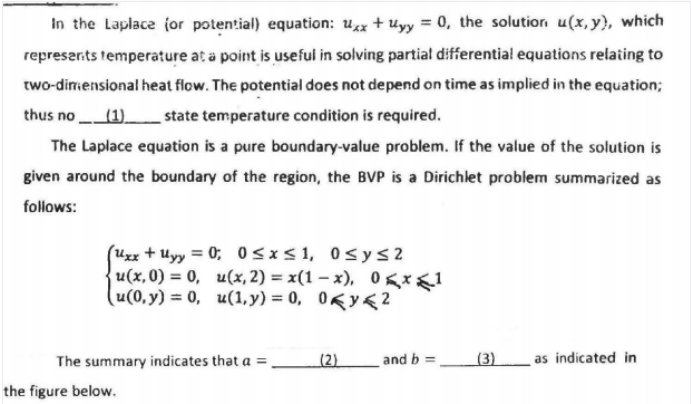In the Laplace (or potential) equation: ux + Uyy = 0, the solutior u(x, y), which represerts temperature at a point is useful in solving partial differential equations relating to two-dimensional heat flow. The potential does not depend on time as implied in the equation; thus no (1). state temperature condition is required. The Laplace equation is a pure boundary-value problem. If the value of the solution is given around the boundary of the region, the BVP is a Dirichlet problem summarized as follows: (Uxx + Uyy = 0; 0< x< 1, 0sys 2 u(x,0) = 0, u(x, 2) = x(1 – x), 0gx<1 (u(0, y) = 0, u(1, y) = 0, 0Ky< 2 The summary indicates that a = (2) and b (3) as indicated in the figure below.
In the Laplace (or potential) equation: ux + Uyy = 0, the solutior u(x, y), which represerts temperature at a point is useful in solving partial differential equations relating to two-dimensional heat flow. The potential does not depend on time as implied in the equation; thus no (1). state temperature condition is required. The Laplace equation is a pure boundary-value problem. If the value of the solution is given around the boundary of the region, the BVP is a Dirichlet problem summarized as follows: (Uxx + Uyy = 0; 0< x< 1, 0sys 2 u(x,0) = 0, u(x, 2) = x(1 – x), 0gx<1 (u(0, y) = 0, u(1, y) = 0, 0Ky< 2 The summary indicates that a = (2) and b (3) as indicated in the figure below.
Advanced Engineering Mathematics
10th Edition
ISBN:9780470458365
Author:Erwin Kreyszig
Publisher:Erwin Kreyszig
Chapter2: Second-order Linear Odes
Section: Chapter Questions
Problem 1RQ
Related questions
Question
Fill in the blanks

Transcribed Image Text:In the Laplace (or potential) equation: ux + uyy = 0, the solutior u(x,y), which
represerits temperature at a point is useful in solving partial differential equations relating to
two-dimensional heat flow. The potential does not depend on time as implied in the equation;
thus no (1).
state temperature condition is required.
The Laplace equation is a pure boundary-value problem. If the value of the solution is
given around the boundary of the region, the BVP is a Dirichlet problem summarized as
follows:
(Uzx + Uyy = 0; 0<x<1, 0s ys2
u(x,0) = 0, u(x, 2) = x(1 – x), 0 gx1
(u(0, y) = 0, u(1, y) = 0, 0Ky< 2
%3D
The summary indicates that a =
(2)
and b
(3)
as indicated in
the figure below.
Expert Solution
This question has been solved!
Explore an expertly crafted, step-by-step solution for a thorough understanding of key concepts.
This is a popular solution!
Trending now
This is a popular solution!
Step by step
Solved in 3 steps

Recommended textbooks for you

Advanced Engineering Mathematics
Advanced Math
ISBN:
9780470458365
Author:
Erwin Kreyszig
Publisher:
Wiley, John & Sons, Incorporated

Numerical Methods for Engineers
Advanced Math
ISBN:
9780073397924
Author:
Steven C. Chapra Dr., Raymond P. Canale
Publisher:
McGraw-Hill Education

Introductory Mathematics for Engineering Applicat…
Advanced Math
ISBN:
9781118141809
Author:
Nathan Klingbeil
Publisher:
WILEY

Advanced Engineering Mathematics
Advanced Math
ISBN:
9780470458365
Author:
Erwin Kreyszig
Publisher:
Wiley, John & Sons, Incorporated

Numerical Methods for Engineers
Advanced Math
ISBN:
9780073397924
Author:
Steven C. Chapra Dr., Raymond P. Canale
Publisher:
McGraw-Hill Education

Introductory Mathematics for Engineering Applicat…
Advanced Math
ISBN:
9781118141809
Author:
Nathan Klingbeil
Publisher:
WILEY

Mathematics For Machine Technology
Advanced Math
ISBN:
9781337798310
Author:
Peterson, John.
Publisher:
Cengage Learning,

